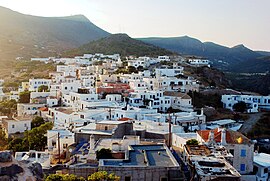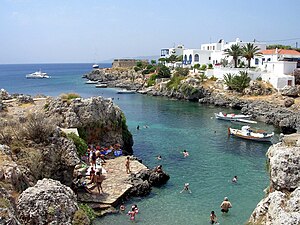Kythira
From Wikipedia, the free encyclopedia
For other uses, see Cythera (disambiguation).
| Kythira Κύθηρα | |
|---|---|

Cythera's capital (Chora) with the Castle
| |
| Coordinates: 36°15′N 23°00′ECoordinates: 36°15′N 23°00′E | |
| Country | Greece |
| Administrative region | Attica |
| Regional unit | Islands |
| Government | |
| • Mayor | Eustathios Harhalakis (Ευσταυιος Χαρχαλακις) (Ind.) |
| Area | |
| • Municipality | 299.4 km2 (115.6 sq mi) |
| • Municipal unit | 279.6 km2 (108.0 sq mi) |
| Elevation | 506 m (1,660 ft) |
| Population (2011)[1] | |
| • Municipality | 4,041 |
| • Municipality density | 13/km2 (35/sq mi) |
| • Municipal unit | 3,973 |
| • Municipal unit density | 14/km2 (37/sq mi) |
| Community | |
| • Population | 665 |
| Time zone | EET (UTC+2) |
| • Summer (DST) | EEST (UTC+3) |
| Postal code | 801 00 |
| Area code(s) | 2736 |
| Vehicle registration | Z |
| Website | www.kythira.gr |
Kythira (/kᵻˈθɪrə/; Greek: Κύθηρα, also transliterated as Cythera, Kythera and Kithira[2]) is an island in Greece lying opposite the south-eastern tip of the Peloponnese peninsula. It is traditionally listed as one of the seven main Ionian Islands, although it is distant from the main group. Administratively, it belongs to the Islands regional unit, which is part of the Attica region (although at large distance from Attica itself).
For many centuries, while naval travel was the only means for transportation, the island possessed a strategic location. From ancient times until the mid 19th century, Kythira was a crossroads of merchants, sailors, and conquerors. As such, it has had a long and varied history and has been influenced by many civilisations and cultures. This is reflected in its architecture (a blend of traditional, Aegean and Venetian elements), as well as the traditions and customs, influenced by centuries of coexistence of the Greek, Venetian, and Ottoman cultures
Climate[edit]
Kythira has a Mediterranean climate (Köppen climate classification Csa) with mild, rainy winters and warm to hot dry summers.[7]
| [hide]Climate data for Kythira Island | |||||||||||||
|---|---|---|---|---|---|---|---|---|---|---|---|---|---|
| Month | Jan | Feb | Mar | Apr | May | Jun | Jul | Aug | Sep | Oct | Nov | Dec | Year |
| Record high °C (°F) | 21.5 (70.7) | 22.8 (73) | 24.0 (75.2) | 27.0 (80.6) | 33.2 (91.8) | 40.0 (104) | 40.2 (104.4) | 37.8 (100) | 33.6 (92.5) | 30.0 (86) | 26.2 (79.2) | 22.6 (72.7) | 40.2 (104.4) |
| Average high °C (°F) | 12.7 (54.9) | 12.9 (55.2) | 14.2 (57.6) | 17.1 (62.8) | 21.6 (70.9) | 26.0 (78.8) | 28.7 (83.7) | 28.5 (83.3) | 25.6 (78.1) | 21.2 (70.2) | 17.8 (64) | 14.6 (58.3) | 20.1 (68.2) |
| Daily mean °C (°F) | 10.8 (51.4) | 10.8 (51.4) | 12.0 (53.6) | 14.7 (58.5) | 18.8 (65.8) | 23.0 (73.4) | 25.6 (78.1) | 25.4 (77.7) | 22.9 (73.2) | 18.9 (66) | 15.8 (60.4) | 12.7 (54.9) | 17.6 (63.7) |
| Average low °C (°F) | 8.9 (48) | 8.9 (48) | 10.0 (50) | 12.4 (54.3) | 16.1 (61) | 19.9 (67.8) | 22.4 (72.3) | 22.5 (72.5) | 20.3 (68.5) | 16.8 (62.2) | 13.9 (57) | 10.8 (51.4) | 15.2 (59.4) |
| Record low °C (°F) | −1.8 (28.8) | −0.8 (30.6) | −4.3 (24.3) | 6.2 (43.2) | 9.4 (48.9) | 11.8 (53.2) | 14.8 (58.6) | 17.2 (63) | 11.8 (53.2) | 8.8 (47.8) | 2.0 (35.6) | 1.0 (33.8) | −4.3 (24.3) |
| Average precipitation mm (inches) | 103.3 (4.067) | 67.7 (2.665) | 59.5 (2.343) | 28.1 (1.106) | 10.5 (0.413) | 1.9 (0.075) | 2.4 (0.094) | 2.3 (0.091) | 11.2 (0.441) | 54.2 (2.134) | 85.6 (3.37) | 115.2 (4.535) | 541.9 (21.335) |
| Average precipitation days (≥ 1.0 mm) | 10.2 | 8.5 | 6.4 | 4.0 | 1.7 | 0.3 | 0.3 | 0.3 | 1.1 | 5.1 | 7.7 | 11.0 | 56.6 |
| Average relative humidity (%) | 72.3 | 72.4 | 71.5 | 67.9 | 63.1 | 57.1 | 54.4 | 56.7 | 62.1 | 68.3 | 72.5 | 72.8 | 65.9 |
Source: NOAA[8Villages of Kythira[edit]
The largest villages (2001 Greek census) are Potamós (pop. 396), Agía Pelagía (281), Chóra/Kýthira (267), Áno Livádi (175), Kálamos (157), and Livádi (126).
| |||||||||||||
.




Δεν υπάρχουν σχόλια:
Δημοσίευση σχολίου